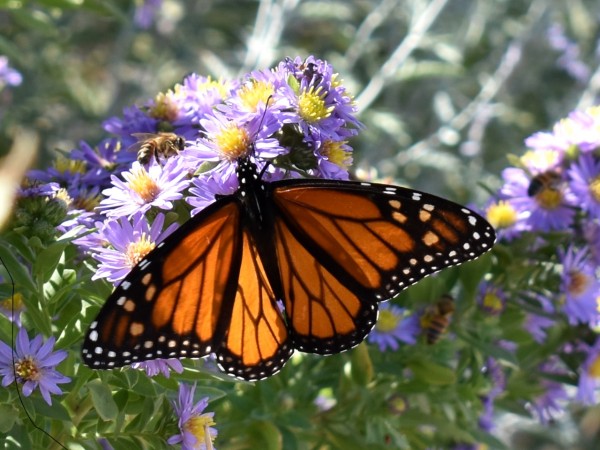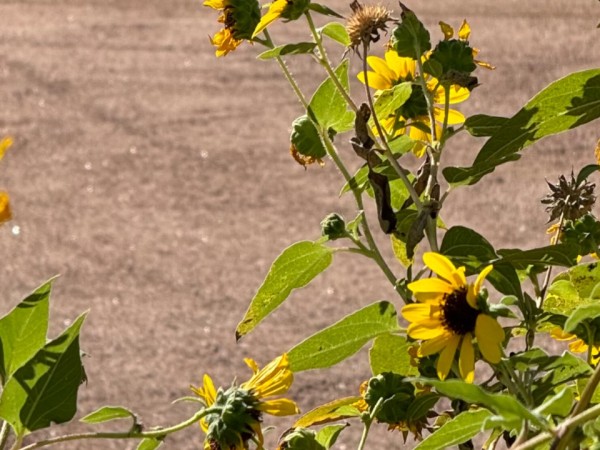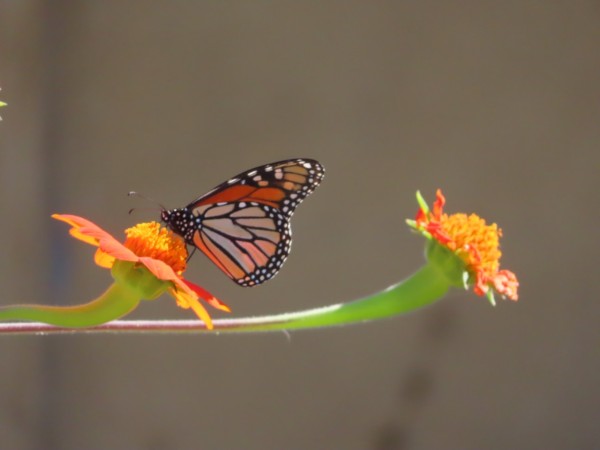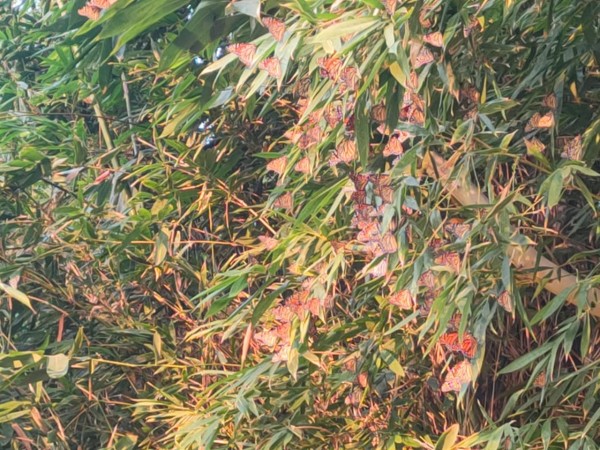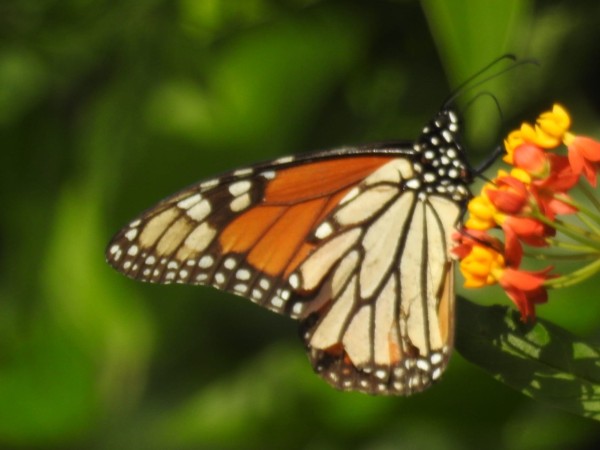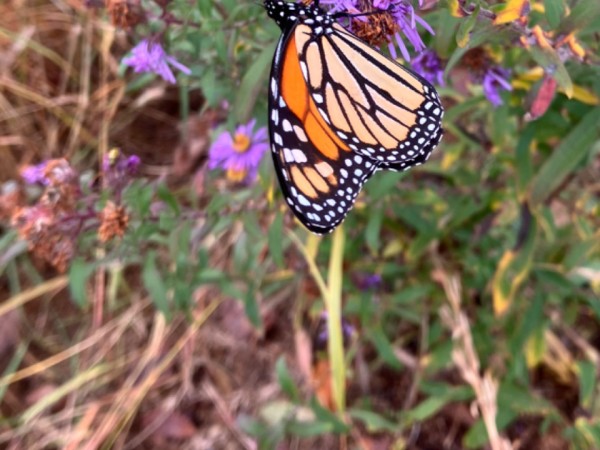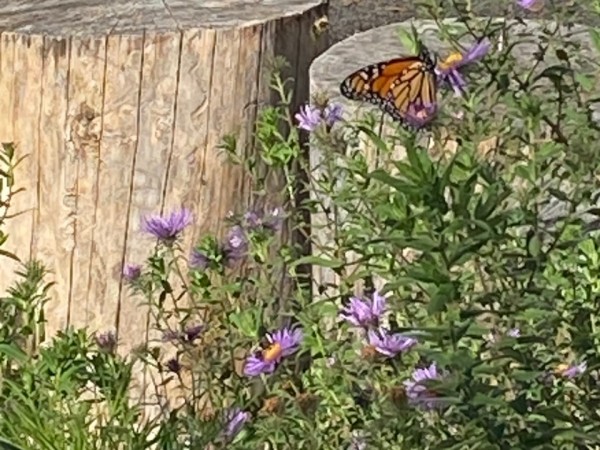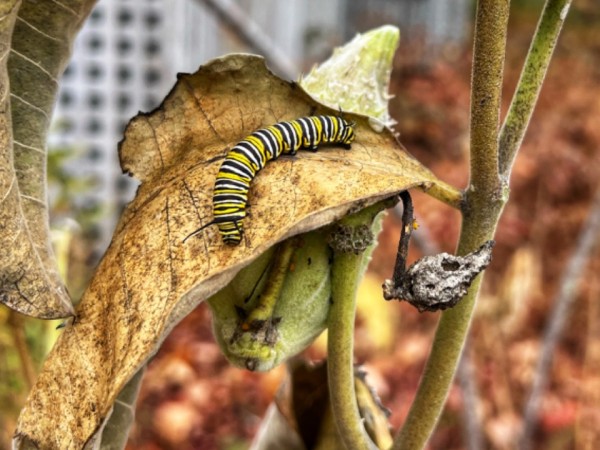Far fewer monarchs in California than last year's initial counts
Monarchs are reaching overwintering sites in California but in lower numbers so far this year. That’s punctuated in Pacific Grove, where over 6,000 monarchs were spotted on Nov. 3 last year. This year, just 18 monarchs were spotted during a count on Nov. 1.
It was a late season across much of the continent, and a heat wave seemed to slow monarch movement throughout the fall, so it remains to be seen whether that delay will continue and sightings will pick up in the coming days or weeks.
Western monarch update
By Gail Morris, Southwest Monarch Study coordinator
The monarch fall migration has finally reached the lower portions of Arizona and New Mexico on the final leg of their journey to their overwintering sites. In California, monarchs are arriving at the coastal overwintering sites in dramatically smaller numbers than in earlier years, raising concern.
But there is still hope that more monarchs will arrive in greater numbers in the days to come before the annual Thanksgiving count. Your reports will help us see where the monarchs are in their journey.
From the field
Stephanie Turcotte provided an update from Pacific Grove, California after Pacific Grove’s first official count of the season on Nov. 1:
“I wish that I had better news for our monarch count this morning in and around the Pacific Grove habitat. It was cool (44 degrees) and calm in the grove. While we did increase from the six [monarchs] last week, today’s count was 18 monarchs, all loners. We had to search for those and were very excited each time we found another one! They were spread along three boundaries of the grove on six trees: mature eucalyptus in the southern end along the fence line, a cypress and eucalyptus along the hotel fence line in the east, a pine in the west, and a few sprinkled on the eucalyptus in the southeast corner over the neighbors’ homes. I didn’t see any tags.
“For comparison, last year, we counted 6,137 monarchs on 11/3/23. I am glad that Santa Cruz is seeing clusters. As long as there are SOME monarchs ... somewhere.”
The next day, Stephanie shared her thoughts about the low counts: “I wish that I could say more. It is very sad to walk around in our PG grove and only see a handful. It was like that in 2020, but the entire season was weird because of COVID. It’s dry in our grove and it is quite barren. Perhaps we don’t meet all the requirements that the monarchs need this season, with lack of wind protection and moisture. Santa Cruz has a healthy number between its three to four sites of just over 3,000. Things still have the potential to change over the season. It is why it is important to keep counting week after week.”
Diana Magor shared the results of a recent count on Nov. 1 at Lighthouse Field in Santa Cruz.
“We did a count of Lighthouse Field on Friday, Nov. 1 starting about 8:30 and Beth Bell found 1,178 monarchs. Most were in loose clusters on east and south-facing eucalyptus trees. There were two matings. For comparison, last year (Nov. 4, 2023) I counted 4,900 at Lighthouse Field.”
Thank you to Stephanie Turcotte and Diana Magor for sharing their reports.
Recent monarch sightings
Angele reported one monarch on Oct. 24 in Truth or Consequences, New Mexico. “Gorgeous adult on aster in my garden. 2 p.m., 86 degrees, quite a bit warmer than usual. I don't see monarchs every year, this is my first for this fall. Will be checking the milkweed for eggs later.”
The record-breaking heat wave gripping the Southwest deserts has finally loosened its grip, and monarchs are finally appearing, later than usual. Darlene spotted one monarch on Oct. 26 in Apache Junction, Arizona. “First fall monarch nectaring on common sunflowers. Couldn’t get close enough to tell if male or female. Looked pretty fresh. Made several rounds around the property and kept coming back.”
Della in Phoenix, Arizona, found two monarchs on Nov. 1, writing, “Two monarchs seen at 11:15 a.m. today. One male, one female. Both sitting on Tithonia. Both in good condition. 73F, sunny, no breeze.”
On the same Diana, noticed three monarchs in Tucson, Arizona, writing, "These were the first I've seen this entire year. One monarch was easily identifiable as a male. Butterflies rested in trees or nectared on lantana and Gregg's mistflower.”
Wanted: monarch sightings
Report your monarch sightings! Report adult monarchs, eggs, or larvae to Journey North. Your detailed description of what you see can include, but is not limited to, the monarch’s gender and activity. If known, include the type of flowers if they are nectaring or milkweed type if laying eggs. Photos are encouraged and welcomed with all your reports.
Gail Morris is the coordinator of the Southwest Monarch Study (www.swmonarchs.org). She is also a Monarch Watch conservation specialist, the vice president of the Central Arizona Butterfly Association and sits in several western working groups. You can reach her at gail@swmonarchs.org
Eastern monarch update
By Jacob Swanson, Journey North outreach associate
In Angangueo, home to one of Mexico’s overwintering sites, Journey North writer Estela Romero spotted a lone monarch on Nov. 1, a day after hearing of the first monarch arrivals from locals near Cerro Pelón and El Rosario sanctuaries.
Since then, however, things have been a little bit quiet amid rainy weather, gray skies and heavy mist, as well as drastic temperature drops at night for nearly a week. Angangueo is where the two highest-elevation monarch colonies are located.
In Macheros, which is much lower and warmer, the weather has gotten warmer, but locals say that "monarchs simply stopped arriving after some handfuls had been seen just last week, before this cold front hit us in the whole region," Estela writes.
It should be just a matter of time before monarchs begin to arrive in larger numbers, but time will tell.
In recent weeks, Oscar Alejandro has submitted numerous reports from the area around Lago de Cuitzeo, less than 50 miles from the Monarch Butterfly Biosphere Reserve, including 12 on Nov. 1.
On Nov. 1, Correo Real also passed along a report from Mariano Suárez of 1,500 monarchs in the trees just northeast of Monterrey, which is just over 400 miles north of winter monarch habitat.
And on Nov. 4, Mario reported 40 monarchs in El Cielo Biosphere Reserve, less than 250 miles north.
Northern observations
The northernmost sighting of the week comes from Kathleen in Minesing, Ontario (latitude 44.5) on Oct. 30, with a photo of a monarch clinging on to what’s left of the year’s flowers. “Exceptionally warm day with south wind,” Kathleen wrote, noting that the most recent sighting before this one was over two weeks ago.
Minya in Kingston, New York reported a monarch on Nov. 1, writing, “It’s been unseasonably warm.”
Even in areas further south, monarch watchers are surprised to see them. In Atlanta, Georgia, Elizabeth spotted a female on Nov. 5 and a female on Nov. 6, writing, “Surprising to find them this time of year here. Always a thrill!”
Among the results of this year’s late monarch peak was a late group of caterpillars, which has been cataloged in previous news updates. Those sightings have mostly dried up over the last few weeks, with the last sighting north of South Carolina coming from Mt. Desert, Maine on Oct. 23.
Overwintering monarchs in the southern United States
All of the other larvae sightings from the past few weeks have come from Louisiana, Texas, Florida and Virginia. If you’re in any of these southern states or others like Alabama and Mississippi, let us know what you’re seeing over the winter months.
While the Florida population of year-round monarchs is the most well-known outside of Mexico and California, monarchs may remain in states along the Gulf Coast and Atlantic and even reproduce there, so report your observations throughout the winter.



